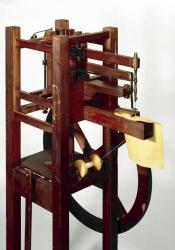Invention of the Sewing Machine
The first widely used sewing machine was invented in 1829 by Barthelemy Thimmonier, a French tailor. It was patented the following year and put into use for making uniforms for the French army. As we have seen in Middlemarch, dressmaking was once a very expensive and exclusive art form, and fashion was reserved for the very wealthy. The fabrics and dyes the women of Middlemarch wear directly correlate to their social status and act as a display of where they stand amongst the people of the city. The invention of sewing machines would change this. Mass production of clothing would mean that it would become significantly cheaper to stay in fashion, thus meaning that lower classes could begin to dress like wealthier people, blurring distinctions between rich and poor. This is significant in a society as divided by money as 19th century England, and the invention of the sewing machine would have a direct impact on how Middlemarch’s women express themselves and their social status through what they wear.
Sewing machine. (2020, September 27). Retrieved October 07, 2020, from https://en.wikipedia.org/wiki/Sewing_machine

